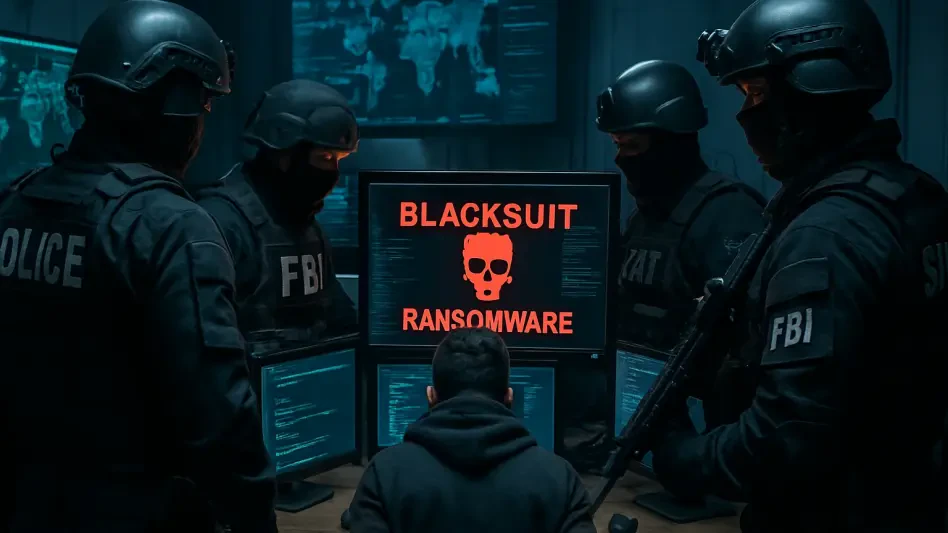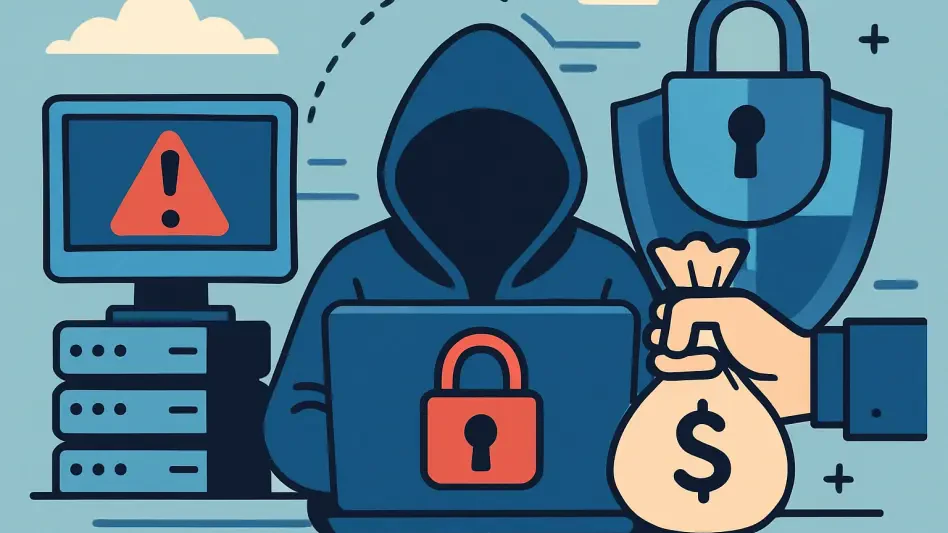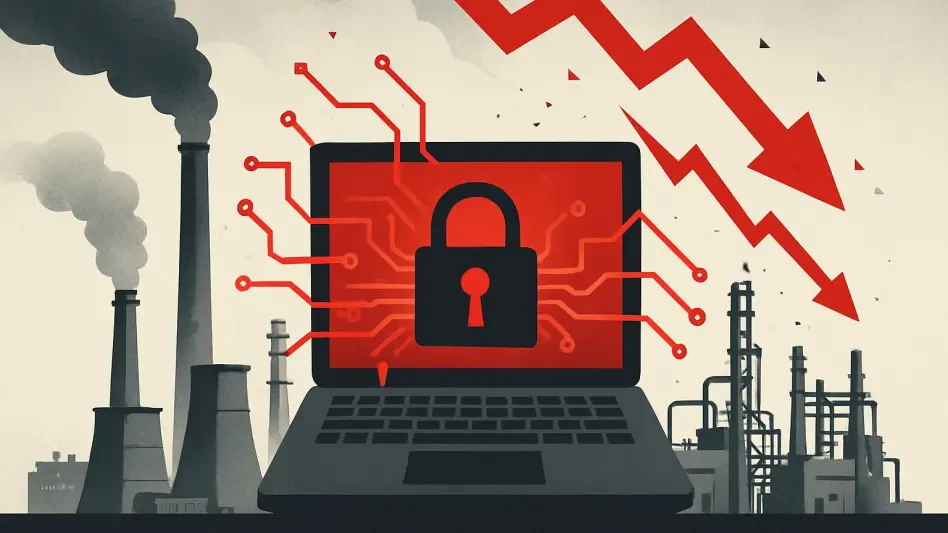Imagine a world where hospitals grind to a halt, energy grids falter, and government systems are held hostage by invisible attackers demanding millions in ransom. This isn’t dystopian fiction but a stark reality faced by over 450 U.S. entities targeted by the BlackSuit ransomware group, with losses exceeding $370 million. The recent dismantling of this notorious cybercrime network by the U.S. Department of Homeland Security (DHS) and international partners marks a pivotal moment in the fight against ransomware. This roundup gathers insights, strategies, and perspectives from various cybersecurity experts and law enforcement viewpoints to dissect the operation, explore its implications, and offer actionable takeaways for organizations and policymakers aiming to fortify defenses against such pervasive threats.
Exploring the BlackSuit Threat and Global Ramifications
The emergence of BlackSuit as a successor to the Royal ransomware group has sent ripples through critical sectors like healthcare, energy, and public safety across the globe. Cybersecurity experts note that this group’s sophisticated attacks, often targeting essential services, expose the fragility of interconnected systems. Their ability to cripple operations and extract hefty ransoms underscores a growing menace that transcends borders, demanding urgent attention from both private and public entities.
Analysts highlight the scale of disruption caused by BlackSuit, pointing to the double-extortion tactics that encrypt data and threaten to leak sensitive information. This dual approach not only maximizes financial gain but also amplifies the psychological pressure on victims. Many in the industry argue that such strategies reveal a shift in cybercrime toward more aggressive and damaging methods, pushing the need for robust preventive measures to the forefront of organizational priorities.
Beyond the immediate impact, there’s a consensus that ransomware poses a systemic risk to global stability. Thought leaders in digital security stress that targeting infrastructure vital to societal function—hospitals unable to access patient records or energy providers facing outages—creates a domino effect of consequences. This perspective sets the stage for understanding why coordinated, multinational efforts are no longer optional but imperative in curbing these digital assaults.
Operation Checkmate: Insights into a Unified Cyber Strike
Dissecting the Disruption of BlackSuit’s Infrastructure
Operation Checkmate, led by DHS and its allies, targeted the core of BlackSuit’s operations by seizing servers, domains, and digital assets used for ransomware distribution and extortion. Cybersecurity professionals commend the strategic focus on dismantling the technical backbone, noting that such actions disrupt immediate threats and send a strong message to other criminal networks. The operation’s scope, impacting a group responsible for over $370 million in ransom payments, illustrates the magnitude of the challenge faced by law enforcement.
Feedback from tech security forums suggests that while seizing infrastructure is a significant win, the complexity of double-extortion schemes poses ongoing hurdles. Attackers often retain stolen data even after systems are shut down, creating lingering risks for victims. This observation points to a gap in fully neutralizing threats, as restoring trust and securing compromised information remains a daunting task for affected organizations.
A recurring theme among industry watchers is the sheer scale of victimization, with over 450 known U.S. targets spanning multiple critical sectors. This statistic, frequently cited in discussions, drives home the indiscriminate nature of ransomware and the urgent need for enhanced defenses. Many experts argue that while takedowns are effective short-term solutions, they must be paired with long-term strategies to prevent the re-emergence of similar threats under new guises.
Strength in Unity: Global Collaboration Against Ransomware
The success of Operation Checkmate hinges on unprecedented collaboration between agencies like Homeland Security Investigations (HSI), the FBI, Europol, and law enforcement from numerous countries. Cybersecurity coalitions emphasize that this multinational effort exemplifies how shared intelligence and resources can dismantle sophisticated cybercrime networks. The collective approach amplifies impact, allowing for synchronized strikes that individual nations might struggle to achieve alone.
Comparisons to parallel efforts, such as Operation Cronos targeting the LockBit group, reveal a growing trend of cross-border operations gaining momentum. Analysts in the field note that these joint missions create a framework for rapid response and information sharing, critical in a landscape where cybercriminals operate without geographic constraints. This perspective highlights the value of sustained alliances in staying ahead of adaptive threats.
However, some voices in the security community caution that while global partnerships yield results, ransomware groups often evolve in response to enforcement actions. The adaptability of these networks, as seen in BlackSuit’s transition from Royal, suggests that collaborative efforts must be dynamic and anticipatory. This concern prompts discussions on balancing reactive takedowns with proactive measures to disrupt emerging criminal tactics before they escalate.
Adapting to Ever-Changing Cyber Threats
The evolution of ransomware groups like BlackSuit from predecessors such as Royal mirrors a broader pattern of resilience among cybercriminals. Experts tracking these trends observe that as one network is dismantled, others often rise to fill the void, leveraging lessons from past disruptions. This cycle of adaptation poses a significant challenge to law enforcement, requiring constant vigilance and updated strategies to address new iterations of old threats.
Regional variations in attack patterns also draw attention, with some analysts noting that cybercriminals tailor their targets based on local vulnerabilities or high-value sectors. For instance, healthcare in one region might be prioritized over energy in another, reflecting a calculated approach to maximize impact. This diversity in targeting complicates defense efforts, as solutions must be customized to address specific risks in different contexts.
A pressing question among thought leaders is the long-term efficacy of takedowns when new groups continuously emerge. Many argue that while operations like Checkmate are milestones, they are not endpoints. The consensus leans toward integrating technological innovation with policy reform to create barriers that deter the formation of successor groups, emphasizing a need for holistic approaches over isolated victories.
Cutting Off the Financial Lifeline of Cybercrime
Disrupting the financial ecosystem that fuels ransomware is gaining traction as a complementary strategy to technical takedowns. Insights from cybersecurity panels reveal a focus on tracing and blocking illicit proceeds, often laundered through complex cryptocurrency channels. Targeting these monetary flows aims to undermine the profitability of ransomware, a core motivator for criminal activity.
Industry perspectives stress that dismantling financial operations requires as much international cooperation as seizing servers. The interconnected nature of global finance means that money laundering often spans multiple jurisdictions, necessitating harmonized legal frameworks. This viewpoint advocates for tighter regulations on digital currencies and enhanced tracking mechanisms to choke off funding for cybercrime networks.
Speculation among experts centers on how future policies might further erode ransomware’s economic incentives. Suggestions include harsher penalties for facilitating illicit transactions and incentivizing private sector involvement in disrupting payment channels. These ideas reflect a growing recognition that attacking the financial underpinnings is as crucial as targeting the technological ones, offering a dual-front approach to weakening cybercriminal enterprises.
Key Takeaways for Strengthening Cybersecurity Defenses
The BlackSuit takedown offers valuable lessons, with international cooperation standing out as a proven force multiplier in combating ransomware. Security consultants underscore that the involvement of diverse global partners in Operation Checkmate demonstrates the power of unified action, a model that organizations and governments should replicate through shared threat intelligence and joint training initiatives.
Practical advice for businesses includes prioritizing investments in robust cybersecurity frameworks and incident response plans. Many in the field recommend regular system audits, employee training on phishing prevention, and deploying advanced encryption to safeguard data. These steps, while resource-intensive, are seen as essential in mitigating the risk of becoming the next high-profile victim of a ransomware attack.
Collaboration between private entities and public agencies also emerges as a critical theme. Experts advocate for public-private partnerships to develop early warning systems and rapid response protocols, ensuring that both sectors leverage their unique strengths. This cooperative mindset is viewed as a cornerstone for building resilience against future cyber threats, fostering a collective defense that benefits all stakeholders.
Reflecting on the Path Forward After the BlackSuit Operation
Looking back, the dismantling of the BlackSuit ransomware network stands as a testament to what global collaboration can achieve in curbing a devastating cyber threat. The operation not only disrupted a major criminal enterprise but also highlighted the staggering scale of damage—over $370 million in ransoms and hundreds of victims—that ransomware inflicts on society. It serves as a wake-up call for sustained action across borders and sectors.
Moving forward, stakeholders must prioritize the development of innovative cybersecurity tools and policies that anticipate the evolution of threats. Strengthening financial regulations to deter ransom payments and investing in cutting-edge detection technologies are identified as vital next steps. These measures aim to create an environment where cybercrime becomes less viable and riskier for perpetrators.
Additionally, fostering a culture of preparedness among organizations and individuals proves essential. Encouraging regular updates to security protocols, participating in industry-wide threat-sharing platforms, and advocating for legislative support to enhance cyber defenses offer practical pathways to fortify global resilience. These actions ensure that the lessons from this significant operation continue to shape a safer digital landscape for years to come.








